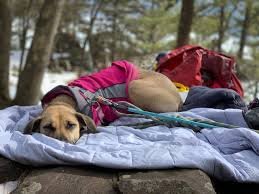Most dog owners eagerly await summer adventures, but ensuring your furry friend’s safety during those outings is equally important. Balancing excitement with precautionary measures will help you enjoy every moment without worry. In this blog post, you’ll discover practical tips and strategies to cultivate a harmonious experience for both you and your canine companion, no matter where your summer escapades take you. From preparing for hikes to understanding hydration needs, you’ll find valuable insights to keep your adventures safe and enjoyable.
The Dos and Don’ts of Summer Adventures with Dogs
Planning exciting summer outings with your canine companion requires a thoughtful approach. Start by always carrying fresh water for your dog, especially on hot days, and schedule regular breaks to prevent overheating. Socialize your pup gradually in crowded areas to gauge their comfort level. Avoid overexerting your dog; instead, tailor the adventure to their fitness level. Most importantly, never leave your dog unattended in a vehicle as temperatures can rise rapidly, leading to heatstroke. Following these guidelines keeps your summer adventures enjoyable and safe for both of you.
Essential Safety Gear for Outdoor Activities
Before launching on your summer escapades, equip your dog with the right safety gear to enhance their protection. A well-fitted harness is ideal for hikes, preventing your dog from slipping out while also providing you with better control. Dog booties can protect those sensitive paws from hot pavement and rugged terrain, while reflective vests ensure visibility during evening strolls. Finally, portable water bowls are excellent for hydration breaks, keeping your furry friend refreshed and ready for fun.
Seasonal Hazards: What to Avoid
Summer is a time for fun, but it’s filled with potential hazards for your dog. To keep your furry friend safe, steer clear of stagnant water, which can harbor harmful bacteria. Be cautious of hot pavement that can burn their paw pads, and watch for ticks and other pests that thrive in warm weather. Additionally, certain plants, such as lilies and azaleas, can be toxic if ingested. Staying vigilant and informed about these hazards ensures a healthy, enjoyable summer for your dog.
Increased outdoor activity during summer can also lead to encounters with wildlife, including snakes and poisonous plants. While exploring trails or unmarked areas, consider keeping your dog on a leash to avoid unexpected surprises. Similarly, be wary of the heat—dogs can suffer from heat exhaustion quickly, especially breeds with shorter snouts. Plan your adventures during cooler parts of the day and always keep your dog’s hydration needs in mind. By anticipating these seasonal hazards, you can protect your dog and enjoy every moment spent outdoors together.
Designing Dog-Friendly Itineraries
Your summer adventures can be enhanced by thoughtfully planning dog-friendly itineraries that cater specifically to your canine companion’s needs and preferences. Consider including activities that promote physical exercise while allowing for periods of downtime to recharge. By mapping out pet-friendly destinations, parks, and trails, you can ensure a well-balanced experience that keeps both you and your dog engaged and happy throughout your journey.
Choosing Locations with Canine Considerations
Selecting locations that are both adventurous and welcoming to dogs is crucial for a successful trip. Research pet-friendly accommodations, restaurants, and parks to make your stay hassle-free. Look for destinations that have designated dog areas, leash-free parks, or scenic trails that cater to various energy levels, ensuring your canine can thrive in the environment you choose.
Balancing Adventure and Rest
Striking the right balance between adventure and rest is vital for your dog’s well-being during your summer outings. Active days filled with exploration should be complemented by periods of relaxation, allowing your furry friend to recuperate. Plan for breaks every couple of hours, giving your dog time to hydrate, enjoy a snack, or simply unwind in the shade. Additionally, consider scheduling shorter activities or leisurely strolls mixed with longer hikes, catering to your dog’s energy levels and keeping them comfortable in the heat.
Training Your Dog for Summer Outings
Effective training lays the groundwork for safe and enjoyable outings with your dog this summer. Start with gradual exposure to new environments, allowing your dog to familiarize themselves with different sights, sounds, and smells. Consider incorporating positive reinforcement techniques to encourage good behavior in bustling areas like parks or beaches. Engaging in fun training sessions focusing on recall, leash walking, and manners can transform stressful encounters into opportunities for bonding. Consistent practice on shorter outings builds confidence and prepares your canine companion for more significant summer adventures ahead.
Building Resilience in Various Environments
Exposing your dog to various environments is vital for building their resilience. Gradually introduce them to busy parks, crowded beaches, or hiking trails with varied terrain. Start in low-stress settings and progressively increase complexity, rewarding them for calm and adaptable behavior. This method not only develops their confidence but also helps them learn to remain focused amid distractions, ensuring a smoother experience during summer escapades.
Commands for Emergency Situations
Teaching your dog imperative commands for emergency situations can be a lifesaver during your summer adventures. Focus on commands like “come,” “leave it,” and “stay,” as these can help you manage unexpected encounters or distractions. Including these commands in your regular training ensures that your dog can respond promptly, even in high-stress scenarios. Regular practice in various settings enhances their reliability and reinforces your bond, giving you peace of mind to fully enjoy your summer outings.
Including emergency commands in your training routine can significantly increase your dog’s safety during outings. The “come” command is particularly vital; a well-trained dog should return to you promptly when called, preventing potential dangers such as running into traffic or engaging with aggressive animals. Teaching “leave it” protects your dog from unwanted consumption of hazardous materials, while “stay” reinforces their ability to remain in place during moments of chaos, like crossing busy streets. Regularly practicing these commands in varied environments helps solidify their effectiveness, fostering a deeper sense of trust and communication between you and your dog.
Essential Hydration and Nutrition Tips for Adventure
To ensure your dog remains vibrant and energetic during your summer adventures, prioritizing hydration and nutrition is vital. Offer fresh, cool water regularly throughout the day, especially after physical activities. Aim for nutritious snacks that can provide short bursts of energy while keeping your dog healthy and happy. Consistency and moderation are key to maintaining optimal health while enjoying the great outdoors. This is your chance to enhance your dog’s experience and your own while exploring new terrains together.
- Provide access to clean water at all times.
- Keep an eye on temperature; dogs can overheat quickly.
- Choose high-quality, protein-rich snacks for energy.
- Monitor your dog’s hydration by checking for dry gums.
- Incorporate hydration packs or collapsible bowls in your gear.
Hydration Frequency and Techniques
Cool, fresh water should be offered every hour or after exercise sessions. Carry collapsible bowls or hydration packs for convenience when you’re out exploring. Encourage your dog to sip small amounts regularly to prevent dehydration instead of waiting until they appear thirsty. Your dog’s hydration needs can vary based on factors like size, age, and activity level, so always assess their needs based on these elements.
Healthy Snacks for Active Dogs
Snacks play a significant role in keeping your pup energized and satisfied. Opt for snacks that are rich in protein and low in fillers, such as freeze-dried meat treats or peanut butter-filled KONG toys. Homemade options like sweet potato chews or pumpkin-based treats are great for maintaining energy levels during outdoor activities.
Healthy snacks should provide more than just tasty rewards; they should contribute to a nutritious diet. For example, incorporating carrot sticks not only supports dental health but also offers low-calorie munching packed with vitamins. Protein-rich snacks like jerky or fish oil treats can offer important fatty acids, which support joint health—ideal for those long hikes or swims. Prioritize snacks that cater to your dog’s activity level, ensuring they’re both a treat and a boost for your active companion.
Recognizing Signs of Distress in Your Dog
Awareness of your dog’s well-being during outdoor adventures is vital to ensure they enjoy the experience just as much as you do. Dogs may not vocalize their discomfort, so observing their behavior is key. Signs of distress can manifest in various ways, ranging from excessive panting to sudden lethargy. Noticing these changes early can help you take action to alleviate any stress or discomfort they may be experiencing, ultimately allowing for a more enjoyable outing.
Behavioral Cues to Watch For
Keep an eye out for specific behaviors that may indicate your dog is struggling. Look for signs like refusing to walk, seeking shade, excessive drooling, or hiding away from the group. If your dog begins to excessively lick their paws or whine, consider these as signals that they may not be comfortable and may need a break or some water. Being attuned to these subtle behavioral changes enhances both safety and your pet’s overall enjoyment.
Health Risks Specific to Summer Adventures
Summer outings can expose your dog to various health risks, including heat exhaustion, dehydration, and even sunburn. Dogs with short snouts, such as Bulldogs or Pugs, are particularly susceptible to overheating. Hydration is critical, as dogs may not always drink enough water during adventurous activities. Furthermore, prolonged exposure to the sun can lead to skin damage, especially in dogs with light-colored fur. Keep a close watch on your furry friend to ensure they stay healthy and happy during your summer escapades.
Heat exhaustion is a serious concern, particularly on warm days. Symptoms may range from heavy panting and drooling to weakness or collapse. If your dog displays such symptoms, find a shaded area, offer water, and cool them down with a damp cloth or fan. Marrying fun with a keen awareness of these signs ensures that adventurous outings remain safe and enjoyable. Additionally, exposure to hot surfaces can burn paw pads, so plan routes carefully to avoid scorching components of your adventure trail.
Final Words
Taking this into account, to cultivate a perfect harmony between adventure and canine safety this summer, you must prioritize planning and preparation. Ensure your activities are dog-friendly, invest in proper gear, and keep your dog’s health and behavior in mind. Regular hydration, sun protection, and knowing your pet’s limits during outdoor excursions will enhance both their enjoyment and safety. By maintaining a balance between exploration and care, you can fully enjoy your summer adventures while ensuring your furry friend remains safe and happy.







